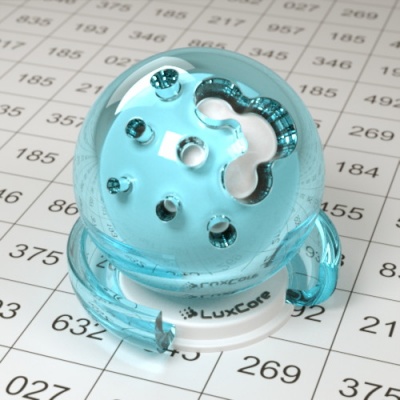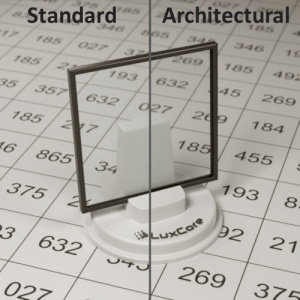Difference between revisions of "LuxCoreRender Materials Glass"
(→Architectural: added a description to the archglass image) |
m |
||
| Line 27: | Line 27: | ||
=== Architectural === | === Architectural === | ||
[[file:Glass_architectural.jpg|300px|thumb|left|For thin sheets of glass the lack of refraction in architectural glass does not matter]] | |||
This option disables refraction during transmission. The effective result is that transmission will appear as though the glass had an IOR of 1.0, while reflections will use the specified IOR. The resulting glass will show only the transmission/reflection colors and volumes effects. You could enable this option for a thin sheet of glass such as a window. The render output difference will be minimal, and it will render much faster, as there is less to compute. However, disable it on any curved glass as it will make the object look fake. | This option disables refraction during transmission. The effective result is that transmission will appear as though the glass had an IOR of 1.0, while reflections will use the specified IOR. The resulting glass will show only the transmission/reflection colors and volumes effects. You could enable this option for a thin sheet of glass such as a window. The render output difference will be minimal, and it will render much faster, as there is less to compute. However, disable it on any curved glass as it will make the object look fake. | ||
| Line 32: | Line 33: | ||
[[ | |||
<br clear="all"/> | |||
Back to [[LuxCoreRender_Materials|Materials]] | |||
<!-- Cauchy B Not yet available in LuxCore. | <!-- Cauchy B Not yet available in LuxCore. | ||
=== Thin Film === | === Thin Film === | ||
Revision as of 21:08, 18 December 2017
The glass material represents a smooth dielectric substance. It works well for materials such glass, crystals, clear liquid, transparent plastic, and gemstones.
Options
IOR
The index of refraction for the material. This value determines the overall appearance of the material, and should be set according to the material you are trying to simulate.
Reflection Color
This is the color of light reflected from the surface.
Transmission Color
This is the color that the light will be filtered to after being transmitted. The color given here will be applied to the material uniformly, you may wish to derive the color from the objects volume instead.
Architectural
This option disables refraction during transmission. The effective result is that transmission will appear as though the glass had an IOR of 1.0, while reflections will use the specified IOR. The resulting glass will show only the transmission/reflection colors and volumes effects. You could enable this option for a thin sheet of glass such as a window. The render output difference will be minimal, and it will render much faster, as there is less to compute. However, disable it on any curved glass as it will make the object look fake.
There are several other important features to architectural mode, besides reducing the necessary calculations of the material. Because there is no refraction during transmission, architectural glass is transparent to shadow rays and alpha, neither of which is the case in non-architectural mode. This is especially important for window glass. Because it is transparent to shadow rays, it is possible to perform direct light sampling through the window to outside light sources, greatly improving the render efficiency. And because it reflects but still propagates alpha, it allows you to have realistic interior reflections and absorption on the windows, while still being able to composite in a backdrop for the view outside of the window.
Back to Materials

